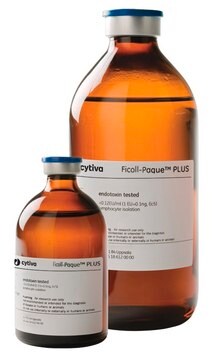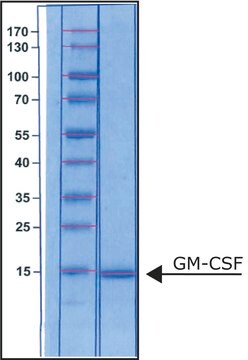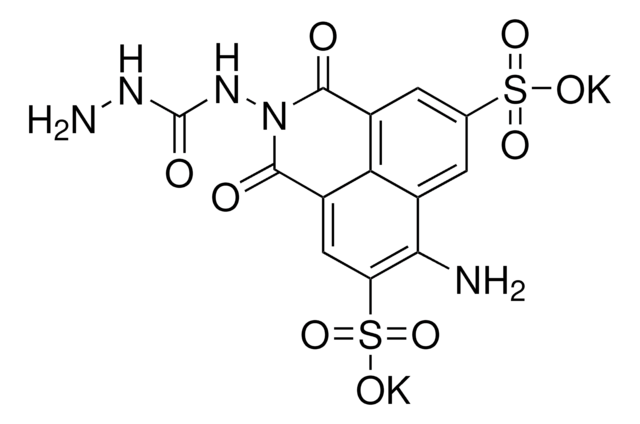M6667
Monocyte Chemotactic Protein-1 human
≥97% (SDS-PAGE and N-terminal analysis), recombinant, expressed in E. coli, lyophilized powder, suitable for cell culture
Synonym(e):
MCP-1
Anmeldenzur Ansicht organisationsspezifischer und vertraglich vereinbarter Preise
Alle Fotos(1)
About This Item
Empfohlene Produkte
Biologische Quelle
human
Qualitätsniveau
Rekombinant
expressed in E. coli
Assay
≥97% (SDS-PAGE and N-terminal analysis)
Form
lyophilized powder
Wirksamkeit
5-60 ng/mL EC50
Mol-Gew.
8.7 kDa
Verpackung
pkg of 10 μg
Methode(n)
cell culture | mammalian: suitable
Verunreinigungen
endotoxin, tested
UniProt-Hinterlegungsnummer
Lagertemp.
−20°C
Angaben zum Gen
human ... CCL2(6347)
Allgemeine Beschreibung
Monocyte chemoattractant protein-1 (MCP-1) or monocyte chemotactic and activating factor (MCAF) is part of the C-C chemokine family. The gene encoding this protein is localized on human chromosome 17q12.
Anwendung
Monocyte chemotactic protein-1 (MCP-1) has been used to study its effects on the motility of lymphoblastoid cell line NC–NC cells.
Biochem./physiol. Wirkung
The biological activity is measured by its ability to chemoattract BaF3 mouse pro-B cells transfected with human CCR2A. The ED<SUB>50</SUB> for this effect is typically 5-30 ng/mL.
Measured by its ability to chemoattract 2-day cultured human monocytes, Matsushima, K., et al. (1989) J. Exp. Med. 169:1485, the ED<SUB>50</SUB> for this effect is typically 5-20 ng/mL.
Monocyte chemoattractant protein-1 (MCP-1) triggers the activation of monocytes by triggering degranulation as well as respiratory burst activity in monocytes. It facilitates monocytes in inhibiting or enhancing the growth of specific brain tumor cell lines. MCP-1 chemoattracts monocytes, macrophages, T cells and natural killer cells. The protein is overexpressed in atherosclerosis, idiopathic pulmonary fibrosis, rheumatoid arthritis and delayed hypersensitivity reactions. It is also implicated in Kawasaki disease.
Measured by its ability to chemoattract 2-day cultured human monocytes, Matsushima, K., et al. (1989) J. Exp. Med. 169:1485, the ED<SUB>50</SUB> for this effect is typically 5-20 ng/mL.
Monocyte chemoattractant protein-1 (MCP-1) triggers the activation of monocytes by triggering degranulation as well as respiratory burst activity in monocytes. It facilitates monocytes in inhibiting or enhancing the growth of specific brain tumor cell lines. MCP-1 chemoattracts monocytes, macrophages, T cells and natural killer cells. The protein is overexpressed in atherosclerosis, idiopathic pulmonary fibrosis, rheumatoid arthritis and delayed hypersensitivity reactions. It is also implicated in Kawasaki disease.
Physikalische Form
Lyophilized from a 0.2 μm filtered solution in phosphate buffered saline containing 0.5 mg bovine serum albumin.
Lagerklassenschlüssel
11 - Combustible Solids
WGK
WGK 2
Flammpunkt (°F)
Not applicable
Flammpunkt (°C)
Not applicable
Persönliche Schutzausrüstung
Eyeshields, Gloves, type N95 (US)
Hier finden Sie alle aktuellen Versionen:
Besitzen Sie dieses Produkt bereits?
In der Dokumentenbibliothek finden Sie die Dokumentation zu den Produkten, die Sie kürzlich erworben haben.
99mTc-HMPAO labelling inhibits cell motility and cell proliferation and induces apoptosis of NC?NC cells
Mutation Research. Genetic Toxicology and Environmental Mutagenesis, 631(2), 69-76 (2007)
Interleukin 7 receptor a chain (IL7R) shows allelic and functional association with multiple sclerosis
Simon G Gregory
Nature Genetics, 39(9) (2007)
Expression of monocyte chemoattractant protein-1 in Kawasaki disease: the anti-inflammatory effect of gamma globulin therapy.
Asano T and Ogawa S
Scandinavian Journal of Immunology, 51(1), 98-103 (2000)
Monocyte Chemoattractant Protein-1 (MCP-1/CCL2) Levels and Its Association with Renal Allograft Rejection.
Raza A
Immunological Investigations, 46(3), 251-262 (2017)
Artikel
Lipid Induced Insulin Resistance
Unser Team von Wissenschaftlern verfügt über Erfahrung in allen Forschungsbereichen einschließlich Life Science, Materialwissenschaften, chemischer Synthese, Chromatographie, Analytik und vielen mehr..
Setzen Sie sich mit dem technischen Dienst in Verbindung.








